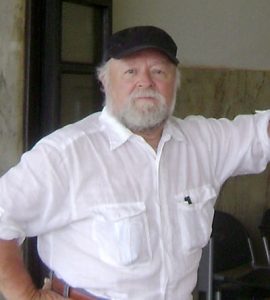Boggs sculpture on display at Chapman Cultural Center
May 26, 2016Chapman Cultural Center has received the modern stainless steel sculpture — Chariot — made by the late Mayo Mac Boggs, one of Spartanburg and South Carolina’s most noted artists. It is now proudly displayed on Chapman’s campus, thanks to the artist’s widow Ansley Boggs, Ed.D., an education professor at Converse College.
 Created in 2005, the piece was first named Constellation by Mr. Boggs. However, in 2010, during Mr. Boggs’s 40th year Retrospective Exhibition on the college campuses of Converse, Wofford, and USC-Upstate, he redubbed it Chariot. In recent years, the piece has been showcased at USC-Upstate’s library. Mr. Boggs passed away in March 2014.
Created in 2005, the piece was first named Constellation by Mr. Boggs. However, in 2010, during Mr. Boggs’s 40th year Retrospective Exhibition on the college campuses of Converse, Wofford, and USC-Upstate, he redubbed it Chariot. In recent years, the piece has been showcased at USC-Upstate’s library. Mr. Boggs passed away in March 2014.
Mr. Boggs had a long and celebrated career in the arts, after humble beginnings as the son of a welder in a Kentucky industrial city. In addition to his more than 40 years of teaching art at Converse College, he kept an active and productive career in creating art. Some of his noted achievements include receiving a 2013 Verner Award, the highest art award given in South Carolina; being named “Professor Emeritus of Art” by Converse College in 2013; and being named “Honorary Artist of Spartanburg” in 1991. Mr. Boggs’s art is placed in the Presidential Libraries of Gerald Ford and Jimmy Carter. His work is located also internationally in permanent collections of numerous corporations. In addition, he has received many sculpture commissions for city parks, public libraries, college campuses, schools, local businesses, and private residences, one of which was for the home of author Lillian Jackson Braun.
In regards to his inspiration and preferred medium, Mr. Boggs once said: “The welded steel sculpture has remained a constant as my medium of expression. I love the look, feel, taste, smell and sound of steel. My great-grandfather was a blacksmith in Kentucky; both my grandfathers and my father were welders and steelworkers. I grew up watching steel pouring from the blast furnaces and the nightly spectacular display of slag being dumped from huge, railroad-sized crucibles. I walked the railroad tracks and picked up scrap metal that had fallen from freight cars. The ironworker’s material and process were an everyday part of my childhood in Ashland, Kentucky. I have taken this material and its process and made art, continuing a family tradition of ironwork.”
In his artist statement, dated March 2011, he wrote: “There are many things one can do to occupy his time while on this earth. I prefer to have non-verbal conversations with my soul. My art is the residue.”
Chariot can be viewed daily at Chapman Cultural Center.

















